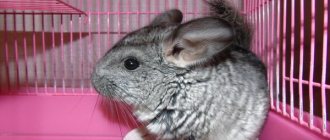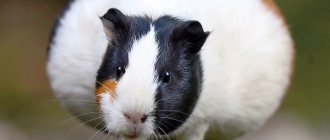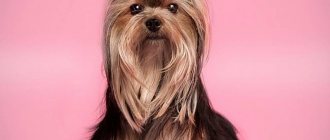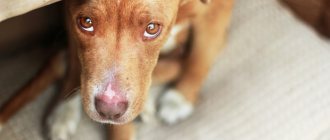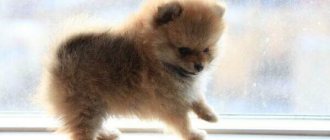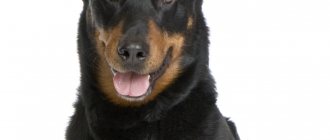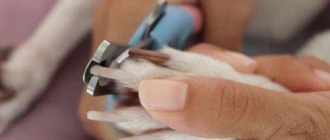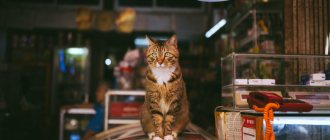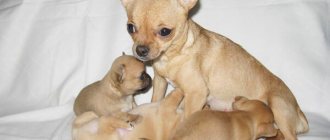The Dachshund is one of the most famous dog breeds. Small stature and an elongated back, prominent muscles and strong teeth, a constant desire for dominance and a bold character - this characterizes cute and attractive dachshunds who really need human care.
Before buying a dog, you need to master the important principles of caring for a dachshund, precise physiological stress, state of health, and in addition, organize housing, remove things that are unsafe for the dog’s existence.
Basic rules for keeping a dachshund
For the owner of a dachshund, it is necessary to know the characteristic features of the given breed. Neglecting them can cause a deterioration in the dog’s health and even death.
Basic principles of caring for a dachshund:
- Care must be taken to prevent the dog from jumping in any way (even jumping from a chair can seriously damage the Dachshund's health).
- It is strictly forbidden to lift the dog by the scruff of the neck.
- It is necessary to choose dachshund friends (other dogs) who do not differ much in physique and strength.
- Do not allow the puppy to stand on its hind legs. This can cause various problems with the spine.
- You should not pet your dog's ears, as this can cause them to droop.
- Do not let your dog go outside without vaccinations.
How many times a day should you walk?
Dachshund puppies require very frequent walking. Thus, this will give them the opportunity to grow up neat and friendly. It is necessary to take your pet for a walk in the morning, as well as before bedtime and after each meal. An adult dog needs to be walked at least three times a day for thirty minutes.
How and when to bathe?
You can start bathing your dog from a young age. For this purpose, you need to use dog shampoo or baby shampoo. Once every three months this procedure will be enough, but in ordinary water, without the use of detergents, the dachshund can be pampered an unlimited number of times.
Choosing a Collar
It is not recommended to purchase collars made of metal material for your dachshund. Although they are durable, they create real agony for dogs by squeezing the throat. In addition, it is not recommended to purchase very heavy or plastic collars. A good look for this breed would be a collar that is thick in the center so it won't rub or curl.
Choosing a collar for your pet
In addition to all the accessories listed, you need to choose the right collar for your dog. For a dachshund, metal attributes are not a suitable option. Despite all the reliability, they put pressure on the neck, and as a result, wearing them turns into torture for the pet. It is also not recommended to buy too thick, soft models.
The best option is collars with a thickening in the middle. To walk your dog, you additionally need to buy a roulette leash. Recommended length is 3-5 m.
The appearance of a puppy in the house
Before caring for a dachshund puppy, you need to prepare in advance. This includes the physical and psychological preparation of the owner, and all the necessary circumstances should be created for a comfortable life for the animal.
Preparing the site
Before you bring your puppy into your home, you must:
- remove easily accessible electrical wiring;
- purchase food, dishes and other required items;
- organize an area for rest, feeding and toilet;
- wash the floors well and hide outdoor shoes, as the puppy can get sick from various diseases or get poisoned from the dirt;
- give instructions to children on how to behave with a puppy;
- remove bowls with water and food of other pets out of reach;
- get rid of poisonous indoor plants;
- remove household chemicals.
What you need to buy
Here is a short list of what a dachshund owner needs to prepare:
- A house for a dachshund, where the dog will have the opportunity to get away from people. It is necessary that it be made of natural materials, have an easily removable mattress and be cozy. Since a good house is expensive, it is permissible to make it yourself. In this case, it is necessary to make an entrance in a cardboard box and place a pad there. The dachshund will feel protected in the house for the first time.
- Tray and wipes for cleaning up moisture.
- Bowls for food and water. It is better to choose dishes made of stainless metal.
- Nail scissors.
- Collar. For cubs, it is best to purchase a textile collar that will not cause neck discomfort.
- A tape measure for a collar, 4-5 meters long, which will allow the dog to calmly get involved in its own affairs, being under the supervision of the owner.
- Medicines and treatments for fleas and ticks.
- All kinds of toys.
- Bones that the puppy will use to sharpen his teeth.
Organization of a recreation area
An important point in caring for a dachshund at home is choosing a place to rest and sleep:
- It must be located in a quiet corner, without drafts and without heating nearby;
- The mat must be plastic, homogeneous and free of small components. An ideal option is a flannelette blanket;
- A cloth should be placed on the mat, which will need to be replaced if dirty;
- The sleeping area should be located where people are constantly present.
Tray training
It is recommended to remove all carpets from the floor first. To speed up the process, you need to purchase special diapers at the pet store. They absorb moisture well and are not saturated with the smell of urine.
A litter tray should be purchased before you bring your dachshund into the home. Due to their physiological characteristics, puppies of this breed often relieve themselves naturally. Most likely, the baby will ignore the proposed option. He will choose his place in one of the corners of the living space. He shouldn't be punished for this. It is necessary to moisten a small piece of cloth in the left puddle, put it under the diaper, and wash the place where the pet relieved itself thoroughly with a soap solution and vinegar to remove the smell.
If such manipulations are repeated several times, the puppy will learn to navigate, and, therefore, will begin to constantly relieve itself in the potty. Dachshunds are smart dogs, so there are rarely representatives that cannot be toilet trained.
Features of care
How to care for a dachshund in an apartment? It is important for a dachshund not to leave care and maintenance to chance, because a responsive and joyful puppy will turn into a nervous and angry creature.
Flea control
The folk method of getting rid of fleas includes constantly bathing the dog with washing products and combing it with a comb. Fast-acting remedies include the use of a set of special shampoos and flea collars, as well as spray and medications for fleas and insects.
Nail care
The claw should be trimmed with special scissors at least twice a month. It is also necessary to trim the hair between the pads of the toes so that lumps do not roll off and thorns do not stick to the paws.
Eye care
The eyes of a dachshund do not cause much trouble. The oblong muzzle guarantees the necessary distance from the ground, and the structure of the eyes reliably protects it from various external stimuli. However, dachshunds are quite curious and often find themselves in trouble.
Strive to constantly monitor the condition of your dog's eyes:
- Every day, wipe your eyes with a damp cloth soaked in plain water.
- If your eyes become more watery, rinse them with water mixed with a 2% boric acid solution. Processing by brewing black tea is also allowed.
- If your eyes water for more than three days, hurry up and visit the veterinarian.
Dental care
It is necessary to brush your dog's teeth using a regular toothbrush or any hard cloth. You need to take a 3% solution of ordinary table salt, apply it to the brush and carefully clean your teeth. This process is not pleasant for dogs, so it is advisable to end it with a treat - a food bone, with which the dog will independently clean all the remaining areas of the teeth.
Ear care
You should not clean your dachshund's ears very often, as this can cause high wax production and inflammation. It is necessary to clean only if it is heavily soiled using cotton swabs and swabs, as well as special means: polyseptin, leopard.
The ears must be bent back to reveal the articular path, then remove all dirt with a swab soaked in the solution. At the end, three drops of medicine are instilled into the ears.
Grooming
Wool does not require special care. It is enough to bathe and comb the dog on time, and a luxurious look is guaranteed. After any walk you need to wipe your dachshund's paws and belly.
Caring for your smooth-haired dachshund includes helping you get rid of the hair that falls out during the shedding period. Once a day you need to wipe the dog’s fur with a damp hand. With this procedure, the hair sticks to the hand and is easily washed off.
Short-haired dachshunds need to be combed. In order for the dog to like this process, it is allowed to combine it with a walk. After brushing, treat your pet with a tasty treat.
What to do if fleas appear?
When your pet constantly itches and behaves restlessly, you can suspect that it has fleas. In this case, it is necessary to carefully examine the animal. If there are a lot of insects, then they are easy to detect. In small numbers, fleas manifest themselves in feces in the form of brown spots, including on the litter.
Today, special anti-flea products are effective. They are presented in a wide variety, so when choosing, it is recommended to consult a veterinarian and carefully study the instructions for their use.
A common and gentle method of flea control for dachshunds is bathing with a special shampoo. The product is applied to the dog, left on it for a while, and then washed off in the shower. Drops or sprays are indicated as a preventative option. They are effective and have a long-lasting effect. Such drugs are allowed to be used for adult dogs.
After treating the animal, it is important to vacuum the living area and carry out wet cleaning with insecticidal preparations. If there were a lot of fleas, then it is possible that they managed to lay eggs in secluded places. Therefore, after a while, the treatment of the animal will have to be repeated. After you manage to get rid of the insects, it is recommended to change the litter.
Feeding the dachshund
Dog owners are required to exercise strict control over the foods consumed by their beloved pet. The best option is to feed dry food, which contains a set of all the necessary elements. For one kg of a dachshund's weight, 40 g of food is calculated.
A good homemade food would be porridge with meat broth. Several types of porridges need to be cooked in broth and vegetables and meat added. Do not use chicken meat, as it can cause allergies.
Dachshunds are characterized by such properties as gluttony and obesity, so the number of feedings must be strictly controlled. You need to feed twice a day after a walk, or four times, but in small doses.
Organization of walking
For an adult animal, walking 2-3 times a day for 20-30 minutes is required.
The puppy should be taken for a walk in the morning, at night, and also 20 minutes after the end of each meal. Timely walks will help solve the problem of how to train a dachshund to use the toilet on the street, will give it the opportunity to move around and play in the company of its owner. Despite the fact that the dog loves to run and frolic, there is no need to provoke him to jump.
While walking, it is necessary to closely monitor the behavior of the pet, which is capable of bullying other people's dogs, regardless of their size or physical strength. A child who decides to take a walk with a pet should be previously instructed that close contact between the dachshund and other dogs is unacceptable. During the period when the dachshund is in heat, it is not advisable to entrust children with walking the dog.
In the cold season, it makes sense to take care of purchasing comfortable clothes for your four-legged friend. The optimal choice would be overalls and blouses that perform the function of protecting the dog’s chest and do not interfere with bowel movements.
Experienced breeders believe that the dachshund does not need shoes, since its claws naturally wear down during walking. As an exception, an animal can be shod if it walks along a road sprinkled with salts and reagents.
Training and education
How to care for a dachshund puppy during training?
Training a dachshund puppy is not an entirely simple task, and it must be carried out with special rigor so as not to spoil the psychological state of the puppy. Dachshunds are a type of dog that, when allowed, stop obeying their owners. The main problems affecting training are its increased love and desire to continuously contact others.
The Dachshund is a social breed. It is necessary not only to walk with her, but also to participate in games and competitions. Otherwise, the pet will become bored, unwell, hostile and disobedient.
Vaccinations
According to the rules, the first vaccination for dachshunds must be performed by the breeder. After this, the corresponding entry is made in the pet’s veterinary passport. But often a puppy is purchased without vaccinations, so the new owner needs to take care of them. This will prevent infection with dangerous infectious diseases such as plague, enteritis, hepatitis, adenovirus, leptospirosis and rabies.
Common vaccination schedule:
- the first – at 2 months;
- second – 6-7;
- the third - per year.
Today, various types of drugs are used:
- Polyvalent. Protection is provided against several pathologies at once.
- Monovalent. One vaccination is used to protect against a specific disease.
Before each vaccination, the dog must be dewormed. Adults should be vaccinated against infectious diseases and rabies every year.
Health
Vaccinations and preventive work to combat fleas, insects and other parasites can ensure excellent Dachshund health. Before the first vaccination, it is necessary to give deworming medication.
How to care for a Dachshund puppy before vaccinations? The first vaccination is carried out when the puppy is two months old, and the next one at six months of age. Before vaccination, you need to isolate the puppy from contact with other animals and not go for walks in public places. Once a month you need to treat your dog for fleas and ticks.
An important point in caring for your dachshund is maintaining its health, as well as preventing and treating diseases.
The most common diseases
Representatives of this breed most often suffer from the following:
- Acanthosis nigricas is a disorder in which the sebaceous glands malfunction. It causes thickening of the skin and pigmentation on the tummy, chest and legs.
- Swimmer's syndrome is a disorder associated with a lack of calcium in the body. With it, puppies are not able to stand on their paws, crawling on their bellies.
- Discopathy is a displacement, deformation, or defect of the vertebral discs.
- Idiopathic epilepsy - manifested by the occurrence of seizures (muscle tremors, gag reflexes, coordination disorder).
- Enteritis is a disease of the intestinal tract, which is caused by improper feeding or viruses and microbes.
- Alopecia (baldness) is a disease of pigment weakening.
- Contagious diseases - plague, rabies.
In order to avoid the occurrence of various diseases it is necessary:
- when arriving from the street, immediately clean your shoes;
- systematically wash floors;
- do not allow the dog to put found objects into its mouth;
- do not allow contact with street dogs;
- carry out vaccinations in a timely manner.
Description of the breed
The first mention of dachshunds is their depiction on ancient Egyptian frescoes. Modern dogs of this breed are the result of selective breeding. Three categories of dachshund breeds have been developed, which have common features: an elongated body, short legs, long ears that hang down.
Dachshund
Table 1. Anthropological data of dachshunds depending on category.
| Name | Height, cm | Weight, kg |
| Standard | 20 — 27 | 6 — 9 |
| Dwarf | 15 — 20 | 3,5 — 4 |
| Rabbit | 11 — 14 | until 3 |
INTERESTING! Dogs from foreign breeders have longer legs, so their height is higher than average.
The lifespan of a dog is 15 years.
Dachshunds can be long-haired or short-haired, with soft or hard coats. Color ranges from light yellow to dark shades with contrasting tan.
Dachshund color
The animal is agile, with well-developed muscles of the body and limbs. The dog's jaws are also very strong.
